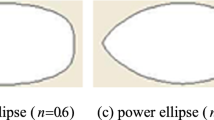Abstract
Scientific principles were developed for predicting the air permeability of textiles based on current concepts concerning the air permeability of textiles and the assumptions of gas and hydrodynamics. Based on the physical concepts concerning flow of gases through porous systems, a theoretical model was elaborated to describe the dependence of the rate of passage of air through fabric on external ambient factors and the characteristics of their structure. The through porosity, thickness, and hydraulic diameter of the pores were determined with the most important characteristics of the structure of the fabrics in the complex index of their structure, with which their air permeability is closely correlated. The possibility of using the model for predicting the air permeability of fabrics was demonstrated. The differences in the results of determining the through porosity of fabrics obtained in using different methods were established during experimental testing of the theoretical model. Because of the very high reliability of the results, the estimation method was approved for use in research. A complex index for their structure which takes into account the effect of the most important structural characteristics — surface density, thickness, average density, filling of the material by the fibre — was proposed based on an analysis of the results of the study of the effect of the structural characteristics of nonwoven materials (NM) on their air permeability. The high degree of correlation of air permeability with this index allows using the dependences obtained with it for predicting the air permeability of NM.
Similar content being viewed by others
REFERENCES
H. D'Arcy, Les Fontaines Publiques de la Ville de Dijon, Paris (1856).
Rubner, Von Levasschev, Arch for Hygiene (1896), p. 29.
E. V. Rekk, Otopl. Ventil., No. 4, 20–27 (1934).
B. Florinskii, Zh. Tekhn. Fiz., 6, No.5, 942–945 (1936).
P. Forchheimer, Hydraulics [Russian translation], Moscow-Leningrad (1935).
V. I. Khanzhonkov, Network Resistance. Industrial Aerodynamics [in Russian], No. 2, TsAGI (1944).
M. F. Zeienko, Air Permeability of Parachute Fabrics with Large Differences in Air Pressures on the Fabric, Candidate Dissertation, Moscow Textile Institute, Moscow (1949).
Kh. A. Rakhmatullin, “Flow around a permeable body,” Vestn. MGU, No. 3 (1950).
N. A. Arkhangel'skii, “Air permeability of fabrics,” in: Performance Properties of Fabrics and Modern Methods of Investigating Them Moscow (1960), pp. 376–413.
K. Sperschneider, Bekleid. Maschenware, 12, No.5, 199–205 (1973).
H. C. Clayton, J. Text. Ins., No. 5, 199–205 (1935).
R. Keswell, Textile Fibres, Yarns, and Fabrics [Russian translation], Izd. Nauchno-Tekhn. Lit. RSFSR, Moscow (1960).
W. E. Morton and J. W. S. Hearle, Physical Properties of Textile Fibres, Heinemann, London (1975), pp. 135–143.
R. Meredith and J. W. S. Hearle, Physical Methods of Investigating Textiles, Textile Book Publishers, New York (1959).
G. E. R. Lamb, P. Constanza, and B. Miller, Textile Res. J., Part 1, 46, No.6 (1975); Part 2, 49, No. 2 (1979); Part 3, 50, No. 6 (1980).
N. I. Gorbach, Izv. Vyssh. Uchebn. Zaved., Tekhnol. Tekst. Prom., No. 3, 8–13 (1968).
E. V. Kondratskii and V. E. Karpov, Evaluation of the Air Permeability of Fabrics in Textiles. Merchandising and Light Industry [in Russian], No. 2, Vyseishaya Shkola, Minsk (1975), pp. 134–136.
E. V. Kondratskii, Izv. Vyssh. Uchebn. Zaved., Tekhnol. Tekst. Prom., No. 4, 30–34 (1972).
V. K. Kothari and A. Newton, Text. Ins., 65, 525–531 (1974).
Yu. S. Shustov and N. V. Goryachev, Khim. Volokna, No. 2, 47–50 (2002).
Blasius, Der Ahnlichkeitsgesetz bei Reibungsvorgangen in Flussigkeiten. Mitt. Forschungsarbeiten, VDI, No. 131 (1913).
I. E. Idel'chik, Handbook of Pressure Losses [in Russian], Gosenergoizdat, Moscow-Leningrad (1960), p. 49.
I. V. Korotkova and V. I. Bukharin, Theoretical and Experimental Study of the Air Permeability of Textile Materials [in Russian], submitted to TsNIITEIlegprom, Moscow (1983), No. 868.
A. V. Kulichenko and L. Van Langenhove, J. Text. Ins., No. 1, 127–132 (1992).
A. V. Kulichenko, Tekst. Prom-st', No. 6, 22–24 (1995).
A. V. Kulichenko, Development of Models and Experimental Methods of Investigation of the Air Permeability of Textile Materials, Doctoral Dissertation, MGUDIT, St. Petersburg (2005).
G. N. Kukin, A. N. Solov'ev, and A. I. Koblyakov, Textile Materials Science [in Russian], Vol. 3, Legprombytizdat, Moscow (1992).
A. V. Kulichenko, Khim. Volokna, No. 3, 31–33 (1995).
A. V. Kulichenko, Fibre Chem., 27, No.3, 168–171 (1995).
A. V. Kulichenko, Izv. Vyssh. Uchebn. Zaved., Tekhnol. Tekst. Prom., No. 1, 26–29 (2005).
V. Subramaniam, M. Madhusoothanan, and R. C. Debnath, J. Text. Inst., 58, No.11, 677–678 (1988).
A. V. Kulichenko and L. van Langenhove, Vlakna Textil, No. 1, 33–37 (1994).
Author information
Authors and Affiliations
Additional information
__________
Translated from Khimicheskie Volokna, No. 5, pp. 47–54, September–October, 2005.
Rights and permissions
About this article
Cite this article
Kulichenko, A.V. Theoretical Analysis, Calculation, and Prediction of the Air Permeability of Textiles. Fibre Chem 37, 371–380 (2005). https://doi.org/10.1007/s10692-006-0011-6
Issue Date:
DOI: https://doi.org/10.1007/s10692-006-0011-6




